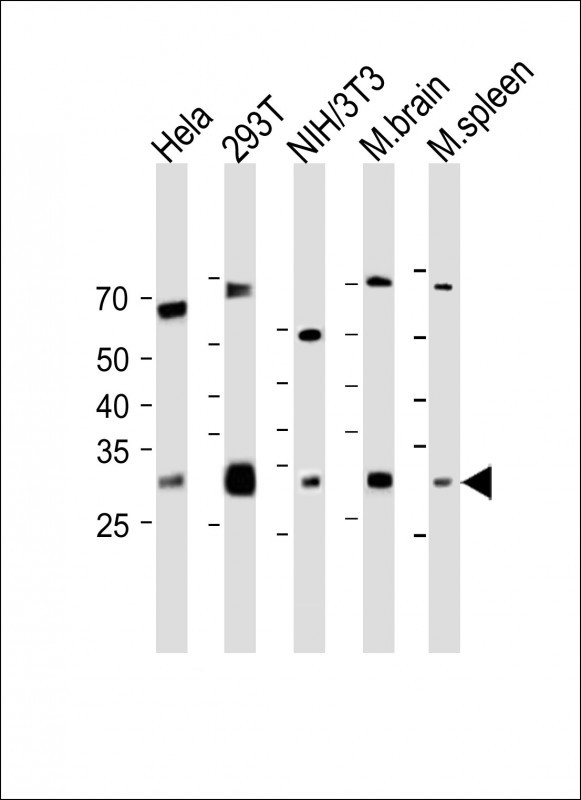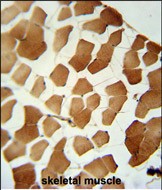PPP6C Antibody (C-term)
Purified Rabbit Polyclonal Antibody (Pab)
- 产品详情
- 文献引用 : 1
- 实验流程
- 背景知识
Application
| WB, IHC-P, E |
|---|---|
| Primary Accession | O00743 |
| Other Accession | Q64620, Q9CQR6 |
| Reactivity | Human |
| Predicted | Mouse, Rat |
| Host | Rabbit |
| Clonality | Polyclonal |
| Isotype | Rabbit IgG |
| Calculated MW | 35144 Da |
| Antigen Region | 275-305 aa |
| Gene ID | 5537 |
|---|---|
| Other Names | Serine/threonine-protein phosphatase 6 catalytic subunit, PP6C, Serine/threonine-protein phosphatase 6 catalytic subunit, N-terminally processed, PPP6C, PPP6 |
| Target/Specificity | This PPP6C antibody is generated from rabbits immunized with a KLH conjugated synthetic peptide between 275-305 amino acids from the C-terminal region of human PPP6C. |
| Dilution | WB~~1:500 IHC-P~~1:100~500 E~~Use at an assay dependent concentration. |
| Format | Purified polyclonal antibody supplied in PBS with 0.05% (V/V) Proclin 300. This antibody is purified through a protein A column, followed by peptide affinity purification. |
| Storage | Maintain refrigerated at 2-8°C for up to 2 weeks. For long term storage store at -20°C in small aliquots to prevent freeze-thaw cycles. |
| Precautions | PPP6C Antibody (C-term) is for research use only and not for use in diagnostic or therapeutic procedures. |
| Name | PPP6C {ECO:0000303|PubMed:29053956, ECO:0000312|HGNC:HGNC:9323} |
|---|---|
| Function | Catalytic subunit of protein phosphatase 6 (PP6) (PubMed:17079228, PubMed:29053956, PubMed:32474700). PP6 is a component of a signaling pathway regulating cell cycle progression in response to IL2 receptor stimulation (PubMed:10227379). N-terminal domain restricts G1 to S phase progression in cancer cells, in part through control of cyclin D1 (PubMed:17568194). During mitosis, regulates spindle positioning (PubMed:27335426). Down-regulates MAP3K7 kinase activation of the IL1 signaling pathway by dephosphorylation of MAP3K7 (PubMed:17079228). Also participates in the innate immune defense against viruses by desphosphorylating RIGI, an essential step that triggers RIGI-mediated signaling activation (PubMed:29053956). Also regulates innate immunity by acting as a negative regulator of the cGAS-STING pathway: mediates dephosphorylation and inactivation of CGAS and STING1 (PubMed:32474700, PubMed:32753499). CGAS dephosphorylation at 'Ser-435' impairs its ability to bind GTP, thereby inactivating it (PubMed:32474700). |
| Cellular Location | Mitochondrion. Cytoplasm |
| Tissue Location | Ubiquitously expressed in all tissues tested with highest expression levels in testis, heart, kidney, brain, stomach, liver and skeletal muscle and lowest in placenta, lung colon and spleen. |
For Research Use Only. Not For Use In Diagnostic Procedures.

Provided below are standard protocols that you may find useful for product applications.
BACKGROUND
PPP6C belongs to the PPP phosphatase family, PP-V subfamily. Reversible phosphorylation of proteins on serine and threonine residues is an important biochemical event that regulates a broad variety of intracellular processes. The phosphorylation state is determined by the well-controlled balance of activities of serine/threonine-specific protein kinases and protein phosphatases, including PPP6C. Expression levels are highest in testis, heart, and skeletal muscle and lowest in placenta, lung, and kidney. PPP6C can complement mutations in the S. cerevisiae Sit4 and S. pombe ppe1 genes, indicating that PPP6C is the functional homolog of yeast Sit4p and ppe1. Since Sit4p is required for the G1 to S transition of the cell cycle and ppe1 is involved in cell shape control and mitotic division, it has been suggested that PPP6C functions in cell cycle regulation.
REFERENCES
Yang, J., et al., EMBO J. 24(1):1-10 (2005).
Zhou, G., et al., J. Biol. Chem. 279(45):46595-46605 (2004).
Huang, S., et al., J. Biol. Chem. 279(35):36490-36496 (2004).
Swingle, M.R., et al., J. Biol. Chem. 279(32):33992-33999 (2004).
Wechsler, T., et al., Proc. Natl. Acad. Sci. U.S.A. 101(5):1247-1252 (2004).
终于等到您。ABCEPTA(百远生物)抗体产品。
点击下方“我要评价 ”按钮提交您的反馈信息,您的反馈和评价是我们最宝贵的财富之一,
我们将在1-3个工作日内处理您的反馈信息。
如有疑问,联系:0512-88856768 tech-china@abcepta.com.






















 癌症的基本特征包括细胞增殖、血管生成、迁移、凋亡逃避机制和细胞永生等。找到癌症发生过程中这些通路的关键标记物和对应的抗体用于检测至关重要。
癌症的基本特征包括细胞增殖、血管生成、迁移、凋亡逃避机制和细胞永生等。找到癌症发生过程中这些通路的关键标记物和对应的抗体用于检测至关重要。 为您推荐一个泛素化位点预测神器——泛素化分析工具,可以为您的蛋白的泛素化位点作出预测和评分。
为您推荐一个泛素化位点预测神器——泛素化分析工具,可以为您的蛋白的泛素化位点作出预测和评分。 细胞自噬受体图形绘图工具为你的蛋白的细胞受体结合位点作出预测和评分,识别结合到自噬通路中的蛋白是非常重要的,便于让我们理解自噬在正常生理、病理过程中的作用,如发育、细胞分化、神经退化性疾病、压力条件下、感染和癌症。
细胞自噬受体图形绘图工具为你的蛋白的细胞受体结合位点作出预测和评分,识别结合到自噬通路中的蛋白是非常重要的,便于让我们理解自噬在正常生理、病理过程中的作用,如发育、细胞分化、神经退化性疾病、压力条件下、感染和癌症。







